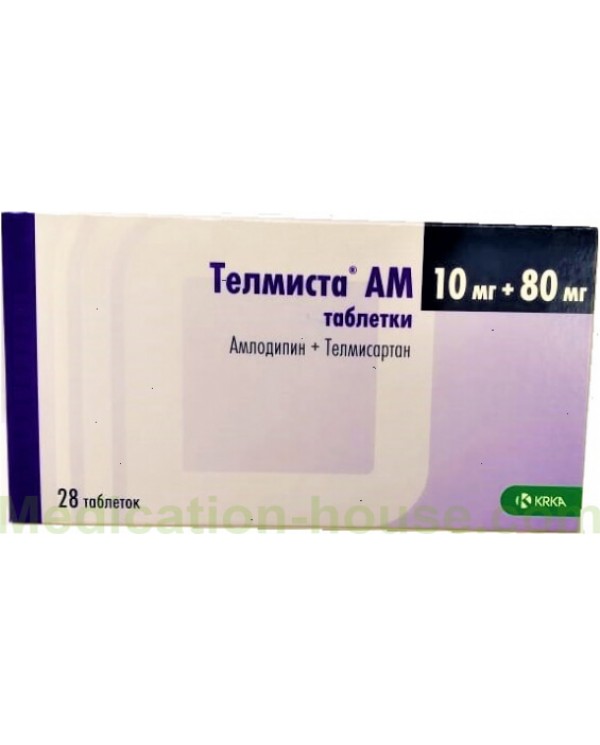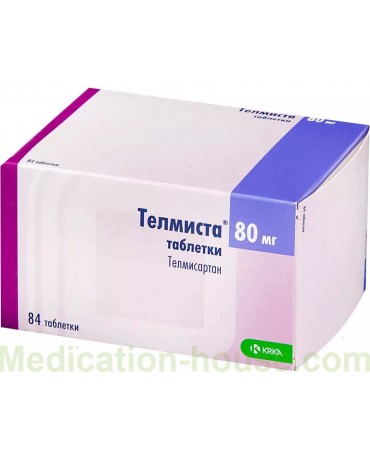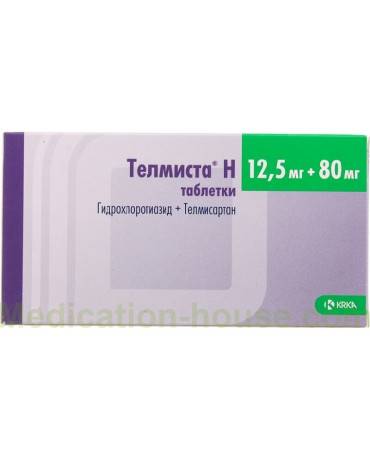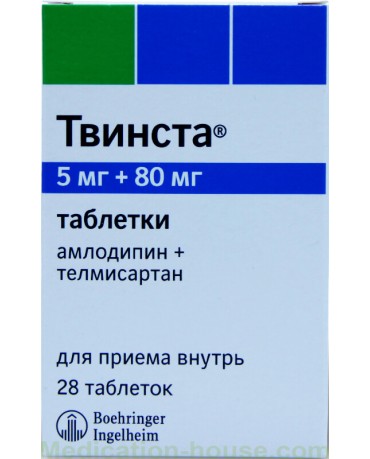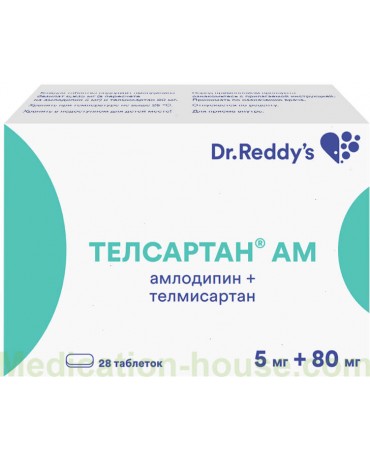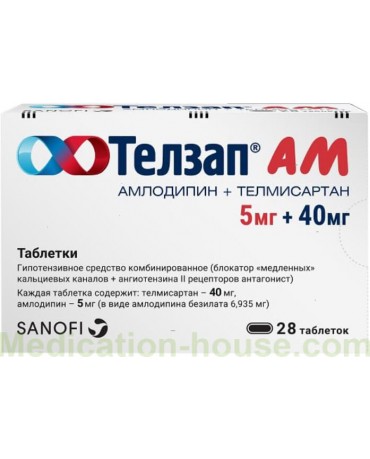Telmista AM instruction
You can buy Telmista AM here
Indications
Arterial hypertension (for patients whose blood pressure is insufficiently controlled by amlodipine or telmisartan in monotherapy).
Arterial hypertension (for patients for whom combination therapy is indicated).
Patients with arterial hypertension receiving amlodipine and telmisartan as separate tablets as a replacement for this therapy.
Contraindications
- Hypersensitivity to amlodipine and / or telmisartan, as well as to any of the excipients (see section "Composition").
- Hypersensitivity to other dihydropyridine derivatives.
- Intolerance to fructose, galactose, lactase deficiency, glucose-galactose malabsorption syndrome.
- Pregnancy.
- Breastfeeding period.
- Age up to 18 years (efficacy and safety have not been established).
- Obstructive diseases of the biliary tract.
- Severe arterial hypotension (systolic blood pressure less than 90 mm Hg. Art.).
- Obstruction of the left ventricular outflow tract (including severe aortic stenosis).
- Hemodynamically unstable heart failure after acute myocardial infarction.
- Shock (including cardiogenic shock).
- Severe liver dysfunctions (class C according to the Child-Pugh classification).
- Simultaneous use with aliskiren and preparations containing aliskiren in patients with diabetes mellitus and / or with moderate or severe renal impairment (GFR less than 60 ml / min / 1.73 m2 body surface area).
- Simultaneous use with ACE inhibitors in patients with diabetic nephropathy.
Carefully
Chronic heart failure (CHF) of non-ischemic etiology of III-IV functional class according to NYHA classification, ischemic heart disease (IHD) with severe obstructive coronary artery disease, acute myocardial infarction (and within 1 month after it), unstable angina pectoris, aortic stenosis, mitral stenosis, idiopathic hypertrophic obstructive cardiomyopathy (GOKMP), arterial hypotension, sick sinus syndrome (severe tachycardia, bradycardia), simultaneous use with inhibitors or inducers of the CYP3A4 isoenzyme (see section "Interaction with other drugs"), bilateral stenosis of the stenosis of the artery of the only functioning kidney, impaired renal function of mild to moderate severity, condition after kidney transplantation (no experience with use), decreased circulating blood volume (BCC) against the background of previous diuretic use, restriction of sodium chloride intake, diarrhea or vomiting , hyponatremia, hyperkalemia, impaired liver function of mild to moderate severity.
Application during pregnancy and during breastfeeding
Telmista AM is contraindicated during pregnancy and during breastfeeding.
There have been no specific studies of the combined preparation of amlodipine and telmisartan during pregnancy and during breastfeeding. The effects associated with the intake of the individual components of the drug are described below.
Pregnancy
- Amlodipine
The limited data available regarding the effects of amlodipine or other BMCCs do not indicate the presence of adverse effects on the fetus. However, there may be a risk of slowing down labor.
- Telmisartan
The use of ARA II is contraindicated during pregnancy. When pregnancy is diagnosed, telmisartan should be discontinued immediately. Alternative therapy should be used as needed.
Preclinical studies of telmisartan did not reveal teratogenic properties, but established the presence of fetotoxicity. It is known that the use of ARA II during the II and III trimesters of pregnancy has a fetotoxic effect (decreased renal function, oligohydramnios, delayed ossification of the fetal skull), and neonatal toxicity (renal failure, arterial hypotension and hyperkalemia) is also observed.
When planning pregnancy, ARA II should be replaced with other antihypertensive drugs with an established safety profile during pregnancy (unless continued use of ARA II is considered necessary).
If ARA II is used during pregnancy, then, starting from the second trimester of pregnancy, it is recommended to conduct an ultrasound scan in order to monitor kidney function and the state of the fetal skull.
Newborns whose mothers received ARA II should be carefully monitored for the development of arterial hypotension.
Breastfeeding period
- Amlodipine
Amlodipine is excreted in human breast milk. In women with pregnancy-related hypertension and receiving amlodipine at an initial dosage of 5 mg per day, the average milk / plasma ratio for amlodipine concentration was 0.85 among 31 lactating women. The dosage of the drug was adjusted if necessary (the average daily dose of amlodipine and the dose, depending on body weight, were 6 mg and 98.7 μg / kg, respectively). The estimated daily dose of amlodipine received by an infant through breast milk is 4.17 mcg / kg.
The use of amlodipine during breastfeeding is contraindicated. If you need to use Telmista AM during lactation, you should stop breastfeeding.
- Telmisartan
There have been no special studies on the excretion of telmisartan in breast milk in women. Animal studies have shown that telmisartan is excreted in the milk of lactating animals. Given the possible adverse reactions, the decision to continue breastfeeding or to discontinue therapy should be made taking into account its importance to the mother.
Impact on fertility
Studies of the effect on human fertility have not been conducted.
In some patients receiving BMCC, biochemical changes in the sperm head were found. However, there is currently no sufficient clinical data regarding the potential effect of amlodipine on fertility. In a study in rats, undesirable effects on fertility were found in males.
Structure
First layer
Active ingredient: Telmisartan 80.00 mg;
Second layer
Active ingredient: amlodipine besylate 13.87 mg, equivalent to amlodipine 10.00 mg.
Release form: 1. Tablets 10mg + 80mg No. 28; 2. Tablets 5mg + 40mg # 28; 3. Tablets 5mg + 80mg # 28; 4. Tablets 10mg + 80mg No. 84; 5. Tablets 5mg + 40mg No. 84; 6. Tablets 5mg + 80mg No. 84.
Mode of application
Inside, 1 time per day, regardless of the time of the meal.
Telmista AM can be prescribed:
- patients receiving the same doses of amlodipine and telmisartan in the form of separate tablets, for the convenience of therapy and increased adherence to treatment;
- patients in whom the use of only amlodipine or only telmisartan does not lead to adequate control of blood pressure. Patients taking amlodipine at a dose of 10 mg, who have HPs that limit the intake of the drug, for example, peripheral edema, can be switched to Telmista AM at a dose of 5 mg + 40 mg 1 time per day, which will reduce the dose of amlodipine, but will not reduce the overall expected antihypertensive effect.
- for the treatment of arterial hypertension: therapy can begin with the use of Telmista AM in the case when it is assumed that it is unlikely to achieve blood pressure control with the help of any one drug. The usual starting dose of Telmista AM is 5 mg + 40 mg once a day. Patients who need a more significant decrease in blood pressure can start taking Telmista AM at a dose of 5 mg + 80 mg once a day.
If, after at least 2 weeks of treatment, an additional decrease in blood pressure is required, the dose of Telmista AM can be gradually increased to a maximum dose of 10 mg + 80 mg once a day.
Telmista AM can be used together with other antihypertensive drugs.
Special patient groups
- Renal dysfunction
In patients with impaired renal function, including in patients on hemodialysis, changes in the dosage regimen are not required. Amlodipine and telmisartan are not removed from the body during hemodialysis.
- Liver dysfunction
In patients with impaired liver function of mild to moderate severity (class A and B according to the Child-Pugh classification) Telmista AM should be used with caution. The dose of telmisartan should not exceed 40 mg once a day.
- Elderly patients
When using Telmista AM in elderly patients, dose adjustment is not required.
- Children and adolescents under the age of 18
Telmista AM should not be prescribed to children and adolescents under 18 years of age, since there are no data on the efficacy and safety of amlodipine and telmisartan in these groups of patients, both in monotherapy and as part of combination therapy.
Special instructions
Amlodipine
- Cardiovascular diseases
The efficacy and safety of the use of amlodipine in hypertensive crisis has not been established.
In acute myocardial infarction, the use of amlodipine is possible only after stabilization of hemodynamic parameters.
In rare cases, in patients with coronary artery disease (especially with severe obstructive coronary artery disease), there was an increase in the frequency, duration and / or severity of angina attacks after starting the use of BMCC or after increasing their dosage.
Although, in general, BMCC should be used with caution in patients with CHF, amlodipine in short- and long-term clinical studies did not increase mortality or the incidence of cardiovascular complications in patients with CHF. Against the background of the use of amlodipine in patients with CHF (III and IV functional classes according to the NYHA classification) of non-ischemic genesis, there was an increase in the incidence of pulmonary edema, despite the absence of signs of progression of heart failure.
- Aortic stenosis, mitral stenosis, GOKMP
Like all drugs with a vasodilating effect, amlodipine should be used with caution in patients with aortic stenosis, mitral stenosis, or HOCMP. In patients with obstruction of the outflow tract of the left ventricle (including severe aortic stenosis), the use of the drug is contraindicated.
- Withdrawal syndrome
Despite the absence of a "withdrawal" syndrome in BMCC, it is advisable to discontinue treatment with amlodipine by gradually decreasing the dose of the drug. Amlodipine does not prevent the development of a withdrawal syndrome when beta-blockers are abruptly discontinued.
- Peripheral edema
Mild to moderate peripheral edema was the most common adverse event reported with amlodipine in clinical trials. The incidence of peripheral edema increases with increasing dose (when using amlodipine at a dose of 2.5 mg, 5 mg and 10 mg per day, edema occurred in 1.8%, 3% and 10.8% of patients, respectively). It is necessary to carefully differentiate peripheral edema associated with the use of amlodipine from the symptoms of progression of left ventricular heart failure.
- Liver dysfunction
No controlled studies have been conducted in patients with impaired liver function. In a small number of patients with mild to moderate hepatic insufficiency, an increase in T1 / 2 of amlodipine was noted. Patients with hepatic impairment, if necessary, the use of amlodipine should be under medical supervision. In some cases (for example, with moderate hepatic impairment), a lower initial dose of amlodipine (2.5 mg per day) is recommended.
- Elderly patients
In elderly patients, T1 / 2 may increase and amlodipine clearance may decrease. In clinical trials, the incidence of AEs in patients> 65 years of age was approximately 6% higher than in younger patients. Changing the doses of amlodipine is not required, but more careful monitoring of patients in this category is necessary.
- Other
During the period of therapy with amlodipine, it is necessary to control body weight and consumption of table salt, the appointment of an appropriate diet is shown.
Maintaining dental hygiene and monitoring by the dentist (to prevent soreness, bleeding and gingival hyperplasia) is necessary.
Telmisartan
- Pregnancy
ARA II should not be started during pregnancy. Except in cases where continued treatment is not considered necessary, in patients planning a pregnancy, these drugs should be replaced with alternative antihypertensive drugs that have a known safety profile for use during pregnancy. In the event that pregnancy is diagnosed, treatment with ARA II should be stopped immediately and, if necessary, alternative treatment should be started.
- Renovascular arterial hypertension
Patients with bilateral renal artery stenosis or arterial stenosis of a single functioning kidney who are taking drugs that affect the RAAS have an increased risk of severe arterial hypotension and renal failure.
- Double blockade of RAAS
There is evidence that the simultaneous use of ACE inhibitors, ARA II or aliskiren increases the risk of arterial hypotension, hyperkalemia and decreased renal function (including ARF). Therefore, double blockade of RAAS by the combined use of ACE inhibitors, ARA II or aliskiren is not recommended.
If double blockade of the RAAS is considered necessary, it should be carried out only under the supervision of a specialist and subject to careful monitoring of renal function, electrolyte concentration and blood pressure.
The simultaneous use of ARA II with drugs containing aliskiren is contraindicated in patients with diabetes mellitus and / or with moderate or severe renal impairment (GFR less than 60 ml / min / 1.73 m2 body surface area) and is not recommended in other patients.
The simultaneous use of ACE inhibitors and ARA II is contraindicated in patients with diabetic nephropathy and is not recommended in other patients.
- Other conditions characterized by activation of the RAAS
In cases of dependence of vascular tone and renal function mainly on the activity of the RAAS (for example, in patients with CHF or kidney disease, including stenosis of the renal arteries), the administration of drugs that affect it may be accompanied by the development of acute arterial hypotension, hyperazotemia, oliguria, and , in rare cases, arrester.
- Liver failure
Telmisartan should not be used in patients with cholestasis, biliary obstruction or severe liver dysfunction (Child-Pugh class C), since telmisartan is excreted mainly in the bile. It is assumed that in such patients, the hepatic clearance of telmisartan is reduced.
- Primary hyperaldosteronism
In patients with primary hyperaldosteronism, antihypertensive drugs, the mechanism of action of which is to inhibit the RAAS, are usually ineffective. Therefore, the use of telmisartan in such cases is not recommended.
- Diabetes
In patients with diabetes mellitus with additional cardiovascular risk (i.e., with concomitant coronary artery disease), the risks of fatal myocardial infarction and sudden cardiovascular death may be increased with antihypertensive drugs such as ARA II and ACE inhibitors.
When using telmisartan in patients with diabetes mellitus receiving insulin or other hypoglycemic drugs, hypoglycemia may occur. Therefore, in such patients, appropriate monitoring of blood glucose concentration should be considered; dosage adjustment of insulin or hypoglycemic drugs may be required if necessary.
- Hyperkalemia
During treatment with drugs that affect the RAAS, especially in the presence of impaired renal function and / or heart failure, hyperkalemia may occur. Hyperkalemia can be fatal in elderly patients, in patients with renal insufficiency, in patients with diabetes mellitus, in patients who are simultaneously receiving other drugs that can increase serum potassium, and / or in patients with intercurrent events.
Before considering the possibility of the simultaneous use of drugs that affect the RAAS, it is necessary to assess the benefit-risk ratio. The main risk factors for the development of hyperkalemia are:
- diabetes mellitus, impaired renal function, age (> 70 years);
- a combination with one or more other drugs that affect the RAAS and / or food supplements containing potassium. Drugs or therapeutic drug classes that can trigger hyperkalemia are potassium salts, potassium-sparing diuretics, ACE inhibitors, ARA II, NSAIDs (including selective COX-2 inhibitors), heparin, immunosuppressants (cyclosporine or tacrolimus), and trimethoprim ;
- intercurrent events, in particular, dehydration, acute decompensation of cardiac activity, metabolic acidosis, deterioration of renal function, sudden deterioration of the kidney (eg, infectious diseases), cell lysis (eg, limb ischemia, rhabdomyolysis, extensive trauma).
Serum potassium should be carefully monitored in these patients.
Amlodipine + telmisartan
- Liver failure
Telmista AM should be used with caution in patients with hepatic impairment.
- Renal dysfunction and conditions after kidney transplantation
There is no experience with the combination preparation containing amlodipine and telmisartan in patients who have recently undergone kidney transplantation. Amlodipine and telmisartan are not removed by hemodialysis. Patients with impaired renal function are recommended to periodically monitor the content of potassium and the concentration of creatinine in the blood serum.
- Decreased BCC and / or hyponatremia
Due to the restriction of consumption of table salt, intensive therapy with diuretics, diarrhea or vomiting, symptomatic arterial hypotension may develop, especially after taking the first dose of the drug. Before using Telmista AM, such conditions require correction. If arterial hypotension occurs while using Telmista AM, the patient should be placed on his back and, if necessary, intravenous saline should be administered. Treatment can be continued after BP has stabilized.
- Stenosis of the aortic and mitral valves, GOKMP
In patients with aortic or mitral stenosis or in patients with GOKMP, the use of Telmista AM, as well as other vasodilators, requires special caution.
- Unstable angina pectoris, acute myocardial infarction
There is no data on the use of Telmista AM in patients with unstable angina pectoris, in the acute period and within one month after myocardial infarction.
- Other
A pronounced decrease in blood pressure in patients with ischemic cardiomyopathy or ischemic heart disease can lead to the development of myocardial infarction or stroke.
Telmista AM is effective in the treatment of black patients (in this population, the renin activity in the blood plasma is usually reduced).
- Special information on excipients
Along with other excipients, Telmista AM contains sorbitol and lactose monohydrate (see section "Composition"), and therefore its use is contraindicated in patients with fructose, galactose intolerance, lactase deficiency, glucose-galactose malabsorption syndrome.
Influence on the ability to drive vehicles, mechanisms
Studies of the effect on the ability to drive vehicles, mechanisms have not been conducted. However, it should be borne in mind that during treatment, there may be ADRs such as fainting, drowsiness or dizziness. Therefore, when driving vehicles or mechanisms, you should be careful. If patients experience these sensations, they should avoid performing such potentially dangerous actions as driving vehicles and mechanisms.
Store at a temperature not exceeding 25C, out of reach of children.
Interaction with other drugs: Interactions between amlodipine and telmisartan have not been identified in clinical studies. Special studies of drug interactions of the combination of amlodipine and telmisartan with other drugs have not been conducted.
I. Combination of active ingredients
- Other antihypertensive drugs
With simultaneous use with other antihypertensive drugs, the antihypertensive effect of Telmista AM may increase.
- Drugs that can lower blood pressure
It can be expected that some drugs, for example, baclofen, amifostine, antipsychotics and antidepressants, due to their pharmacological properties, will enhance the antihypertensive effect of all antihypertensive drugs, including the combined drug Telmista AM. In addition, orthostatic hypotension may be exacerbated by the use of ethanol.
Corticosteroids (systemic use)
A decrease in the antihypertensive effect is possible.
II. Amlodipine
1. Simultaneous use requiring compliance with precautionary measures
- CYP3A4 isoenzyme inhibitors
With simultaneous use with an inhibitor of the isoenzyme CYP3A4 (erythromycin) in young patients and with diltiazem in elderly patients, the concentration of amlodipine in blood plasma increased by 22% and 50%, respectively. However, the clinical relevance of this observation is not clear.
It cannot be ruled out that more active inhibitors of the CYP3A4 isoenzyme (such as ketoconazole, itraconazole, ritonavir) may increase plasma concentrations of amlodipine to a greater extent than diltiazem. Amlodipine should be used with caution in conjunction with inhibitors of the CYP3A4 isoenzyme. However, no undesirable effects associated with this interaction were noted.
- Inducers of isoenzyme CYP3A4
With the simultaneous use of known inducers of the isoenzyme CYP3A4, the concentration of amlodipine in the blood plasma may vary. Thus, it is necessary to control blood pressure and adjust the dose during and after concomitant treatment, especially with potent inducers of the CYP3A4 isoenzyme (eg, rifampicin, St. John's wort preparations).
- Grapefruit and grapefruit juice
The simultaneous use in 20 healthy volunteers of 240 ml of grapefruit juice with a single dose of 10 mg amlodipine taken orally did not lead to a significant effect on the pharmacokinetic properties of amlodipine.
The simultaneous use of Telmista AM with grapefruit or grapefruit juice is not recommended, since in some patients, as a result of increased bioavailability of amlodipine, the antihypertensive effect may increase.
- Amiodarone and quinidine
Although in the study of amlodipine, a negative inotropic effect was usually not observed, nevertheless, some BMCCs can enhance the severity of the negative inotropic effect of antiarrhythmic drugs that cause prolongation of the QT interval.
2. Concurrent use to be taken into account
- Tacrolimus
There is a risk of increased concentrations of tacrolimus when used simultaneously with amlodipine, but the pharmacokinetic mechanism of this interaction is not fully understood. To avoid tacrolimus toxicity, the use of amlodipine in patients receiving tacrolimus requires monitoring tacrolimus concentrations and adjusting the tacrolimus dose when necessary.
- Cyclosporine
There have been no studies of drug interactions between cyclosporine and amlodipine in healthy volunteers or in other populations, with the exception of patients who underwent kidney transplantation, in whom a variable increase in the residual concentration of cyclosporine was observed (on average 0-40%). Consideration should be given to monitoring cyclosporine concentrations in renal transplant patients receiving amlodipine, and reducing cyclosporine doses if necessary.
- Simvastatin
The simultaneous use of amlodipine with simvastatin at a dose of 80 mg led to an increase in the exposure of simvastatin to 77% compared with simvastatin monotherapy. Therefore, the dose of simvastatin should not exceed 20 mg per day.
- Calcium preparations
Calcium supplements can reduce the effect of BMCC.
- Lithium preparations
With the simultaneous use of BMCC (no data for amlodipine) with lithium preparations, it is possible to increase the manifestation of their neurotoxicity (nausea, vomiting, diarrhea, ataxia, tremor, tinnitus).
- Other drugs
The safety of the simultaneous use of amlodipine with digoxin, warfarin, atorvastatin, sildenafil, antacid drugs (aluminum hydroxide, magnesium hydroxide, simethicone), cimetidine, antibiotics and oral hypoglycemic drugs has been established.
With the simultaneous use of amlodipine and sildenafil, it was shown that each drug had an independent antihypertensive effect.
The simultaneous use of amlodipine with cimetidine did not significantly affect the pharmacokinetics of amlodipine. The simultaneous use of amlodipine with atorvastatin, digoxin, warfarin or cyclosporin did not significantly affect the pharmacokinetics or pharmacodynamics of these drugs.
- Inhibitors of the mammalian mechanistic target for rapamycin (mTOR)
MTOR inhibitors such as sirolimus, temsirolimus and everolimus are substrates of the CYP3A isoenzyme. Amlodipine is a weak inhibitor of the CYP3A4 isoenzyme. When used simultaneously with mTOR inhibitors, amlodipine may increase their exposure
III. Telmisartan
Double blockade of the renin-angiotensin-aldosterone system (RAAS)
Dual blockade of RAAS (for example, concomitant use of ACE inhibitors or aliskiren, a direct renin inhibitor with ARA II) is not recommended due to possible impairment of renal function (including ARF).
The simultaneous use of ARA II with drugs containing aliskiren is contraindicated in patients with diabetes mellitus and / or with moderate or severe renal impairment (GFR less than 60 ml / min / 1.73 m2 of body surface area) and is not recommended in other patients.
The simultaneous use of ACE inhibitors and ARA II is contraindicated in patients with diabetic nephropathy and is not recommended in other patients.
1. Simultaneous use is not recommended
- Potassium-sparing diuretics and salt substitutes containing potassium
ARA II, such as telmisartan, reduce potassium loss caused by diuretics. The use of potassium-sparing diuretics, for example, spironolactone, eplerenone, triamterene or amiloride, potassium preparations or potassium-containing salt substitutes, can lead to a significant increase in serum potassium. If their simultaneous use is necessary due to the presence of registered hypokalemia, then treatment should be carried out with caution and with frequent monitoring of the serum potassium content. If concomitant use is indicated in connection with documented hypokalemia, these drugs should be used with caution and serum potassium monitored regularly.
- Lithium preparations
There was a reversible increase in the concentration of lithium in the blood plasma, accompanied by toxic effects, when taking ACE inhibitors. In rare cases, such changes have been reported with the appointment of ARA II, in particular, telmisartan. With the simultaneous appointment of lithium and ARA II preparations, it is recommended to determine the concentration of lithium in the blood plasma.
- Other antihypertensive drugs
An increase in the antihypertensive effect is possible. In one study, with the combined use of telmisartan and ramipril, there was an increase in AUC0-24 and Cmax of ramipril and ramiprilat by 2.5 times. The clinical significance of this interaction has not been established.
2. Simultaneous use requiring compliance with precautionary measures
- Non-steroidal anti-inflammatory drugs (NSAIDs), including acetylsalicylic acid (in doses used as an anti-inflammatory agent), cyclooxygenase-2 (COX-2) inhibitors and non-selective NSAIDs can reduce the severity of the antihypertensive effect of ARA II.
In some patients with renal insufficiency (for example, patients with dehydration or elderly patients with renal insufficiency), the simultaneous use of ARA II and drugs that suppress the activity of COX can lead to additional deterioration in renal function, including the possible development of ARF; these effects are usually reversible. Therefore, this combination should be used with caution, especially in elderly patients. It is necessary to provide patients with adequate hydration, while kidney function should be monitored after the start of the simultaneous use of these drugs and periodically thereafter.
3. Concurrent use to be taken into account
- Digoxin
With the simultaneous use of telmisartan with digoxin, an increase in the median Cmax of digoxin (49%) and the residual concentration of digoxin (20%) was observed. When initiating, adjusting doses and canceling telmisartan, the concentration of digoxin in the blood plasma should be monitored.
Side effects: The most common ADs include dizziness and peripheral edema. Severe syncope may occur in rare cases (less than 1 in 1000 patients).
ADs registered on the basis of experience with amlodipine and telmisartan used as monotherapy, and with their simultaneous use, are presented in accordance with the classification of NRs of the World Health Organization (WHO): very often (> = 1/10), often (> = 1 / 100, <1/10), infrequently (> = 1/1000, <1/100), rarely (> = 1/10000, <1/1000), very rarely (<1/10000), including individual messages, the frequency is unknown (the frequency cannot be estimated from the available data).
HP are distributed by organs and systems in accordance with the MedDRA classification.
Terms of sell
You can buy Telmista AM without a prescription.

